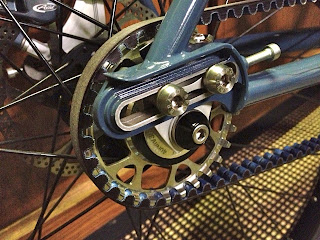Here is the rear gear cluster on my bike. This is a 6-speed removable, freewheeling cluster with a Campagnolo derailleur. It's operated by a cable from the right handlebar. I personally have to gauge how far to move the lever in order to position the chain. It's not difficult, but I have had many years of practice. Most new bikes have "index shifting" which reduces the guesswork.
This diagram shows an overview of the gearing system on a typical bicycle.
On the old Penny Farthing cycles, engineers enlarged the front wheel so the bicycle could go farther for each revolution of the pedals. That made the bike difficult to mount and to steer. There were other drawbacks too, such as sitting right up over the wheel. It could be very painful if you fell off, and painful if you didn't.
Today there are lots of bicycle gearing systems (chain, belt, internal, etc.). The mechanical advantage of any system can be described in terms of "inches".
Here is a friend's new bike with belt drive. Did you think belts were only for Harley-Davidson motorcycles? There are still teeth, so you can count the front and rear teeth and calculate the "inches". There is no derailleur and no inner gear hub, so this is a one-speed bike.
If a wheel diameter is nominally 27 inches, and the pedals are connected in a one-to-one ratio (solid connection penny farthing, chain, belt, internal - doesn't matter), then one revolution of the pedal means one revolution of the wheel. We call that a 27 inch gear.
If the ratio of pedals to wheel is two to one (you go farther per pedal revolution, but it's harder to turn the pedals) then you have a 54 inch gear.
In the old days (when I worked in bike shops and dinosaurs ruled the earth) the highest gear you could easily get was 52 in the front and 13 in the back. That's a 4:1 ratio which means (4 x 27) a 108 inch gear. Unless you are going downhill, or very strong, you can't push this gear.
Calculating gearing can be complicated. Go read more about it on Wikipedia.
By the way, the chain that connects the front and rear pedals on a tandem plays no part in the gearing system. Front and rear are connected 1:1 so there is no mechanical advantage. Sometimes people ask me why I don't put some gearing in so I can do 10% or 20% more work than my poor wife.
Think about it for a minute - if our feet are turning at different rates, our feet could hit each other or the ground. We'd be all out of synch(chronization)!




